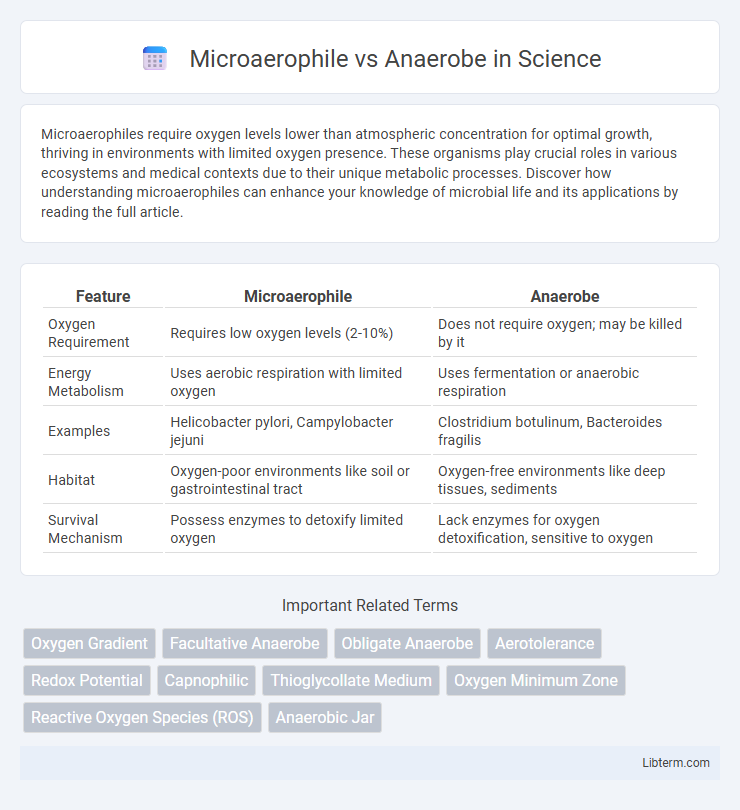Microaerophiles require oxygen levels lower than atmospheric concentration for optimal growth, thriving in environments with limited oxygen presence. These organisms play crucial roles in various ecosystems and medical contexts due to their unique metabolic processes. Discover how understanding microaerophiles can enhance your knowledge of microbial life and its applications by reading the full article.
Table of Comparison
| Feature | Microaerophile | Anaerobe |
|---|---|---|
| Oxygen Requirement | Requires low oxygen levels (2-10%) | Does not require oxygen; may be killed by it |
| Energy Metabolism | Uses aerobic respiration with limited oxygen | Uses fermentation or anaerobic respiration |
| Examples | Helicobacter pylori, Campylobacter jejuni | Clostridium botulinum, Bacteroides fragilis |
| Habitat | Oxygen-poor environments like soil or gastrointestinal tract | Oxygen-free environments like deep tissues, sediments |
| Survival Mechanism | Possess enzymes to detoxify limited oxygen | Lack enzymes for oxygen detoxification, sensitive to oxygen |
Introduction to Microaerophiles and Anaerobes
Microaerophiles require oxygen at lower concentrations than atmospheric levels, typically between 2-10%, to thrive and perform cellular respiration efficiently without oxidative damage. Anaerobes, in contrast, either do not require oxygen for growth or may even find oxygen toxic, relying on fermentation or anaerobic respiration for energy production. Understanding the distinct oxygen preferences and metabolic pathways of microaerophiles and anaerobes is essential for culturing these microorganisms and studying their roles in diverse environmental and clinical settings.
Defining Microaerophiles: Characteristics and Examples
Microaerophiles are microorganisms that require oxygen at lower concentrations than atmospheric levels, typically around 2-10%, to survive and grow. They possess specialized enzymes like cytochrome oxidase that enable efficient energy production under microaerobic conditions, distinguishing them from strict anaerobes which cannot tolerate oxygen. Examples include Helicobacter pylori, which thrives in the low-oxygen environment of the stomach, and Campylobacter species, known for causing foodborne illnesses.
Defining Anaerobes: Types and Key Features
Anaerobes are microorganisms that thrive in environments devoid of oxygen, classified into obligate anaerobes, which cannot survive in the presence of oxygen, and facultative anaerobes, which can grow with or without oxygen. Obligate anaerobes rely on fermentation or anaerobic respiration for energy production, often using electron acceptors like nitrate or sulfate instead of oxygen. Facultative anaerobes possess metabolic flexibility, enabling them to switch between aerobic respiration and anaerobic pathways depending on oxygen availability.
Oxygen Requirements: Microaerophile vs Anaerobe
Microaerophiles require low levels of oxygen, typically around 2-10%, for optimal growth, as they utilize oxygen for respiration but are sensitive to atmospheric concentrations. Anaerobes, in contrast, either cannot tolerate oxygen or grow best in its complete absence, with strict anaerobes being harmed or killed by oxygen exposure. The oxygen requirement distinguishes microaerophiles by their need for reduced oxygen environments, while anaerobes thrive without oxygen or in environments devoid of it.
Metabolic Pathways in Microaerophiles and Anaerobes
Microaerophiles utilize oxidative phosphorylation with limited oxygen as the terminal electron acceptor, optimizing enzymes like cytochrome c oxidase for low-oxygen concentrations, whereas anaerobes rely on anaerobic respiration or fermentation pathways, using alternative electron acceptors such as nitrate, sulfate, or carbon dioxide. The distinct metabolic pathways in microaerophiles involve partially reduced oxygen species detoxification systems, including superoxide dismutase and catalase, contrasting with anaerobic metabolism that often involves reductive enzymes to process organic or inorganic substrates absent oxygen. These adaptations enable microaerophiles to thrive in niches with minimal oxygen, while anaerobes dominate environments devoid of oxygen, reflecting divergent energy conservation strategies.
Environmental Niches and Habitats
Microaerophiles thrive in environments with low oxygen concentrations, such as soil layers, water interfaces, and gastrointestinal tracts, where oxygen levels are reduced but not completely absent. Anaerobes inhabit oxygen-deprived habitats like deep sediments, wetlands, and the human gut, where oxygen presence is toxic or absent, enabling them to utilize alternative electron acceptors for metabolism. These distinct environmental niches reflect adaptations in microbial respiration and energy generation strategies essential for survival under varying oxygen availability.
Medical and Industrial Significance
Microaerophiles require low oxygen levels for optimal growth, making them critical in medical diagnostics and treatment, particularly in identifying Helicobacter pylori infections linked to gastric ulcers. Anaerobes thrive in oxygen-free environments and are pivotal in industrial applications such as wastewater treatment and biogas production, while also causing serious medical conditions like anaerobic infections requiring specialized antibiotic therapies. Understanding the distinct metabolic pathways of microaerophiles and anaerobes facilitates targeted clinical interventions and enhances industrial bioprocess efficiency.
Laboratory Culturing and Identification Techniques
Microaerophiles require oxygen levels of 2-10% for optimal growth, making candle jar incubation or specialized gas packs essential for culturing, whereas anaerobes thrive in oxygen-free environments, necessitating the use of anaerobic chambers or jars with gas-generating sachets. Identification techniques for microaerophiles typically involve observation of growth at reduced oxygen concentrations alongside selective media, while anaerobes require strict anaerobic culture conditions, often confirmed by growth in thioglycollate broth and Gram staining to distinguish obligate from facultative anaerobes. Precise control of oxygen tension and redox potential in the laboratory environment is critical for the successful isolation and identification of these microorganisms.
Common Misconceptions and Clarifications
Microaerophiles require low oxygen levels, typically around 2-10%, contrasting with anaerobes that thrive in oxygen-free environments and may even be harmed by oxygen. A common misconception is that microaerophiles and anaerobes are interchangeable since both avoid atmospheric oxygen, but microaerophiles depend on a limited oxygen supply for respiration. Clarifying these differences is crucial in microbiology, influencing cultivation techniques and clinical treatments for infections caused by these organisms.
Summary: Key Differences between Microaerophiles and Anaerobes
Microaerophiles require oxygen at lower concentrations than atmospheric levels, typically around 2-10%, for optimal growth, whereas anaerobes thrive in environments devoid of oxygen and may be harmed by its presence. Microaerophiles possess enzymes like superoxide dismutase and catalase to detoxify limited oxygen, while obligate anaerobes lack these enzymes, resulting in oxygen sensitivity. The distinct oxygen tolerance and metabolic pathways differentiate microaerophiles, which perform aerobic respiration under reduced oxygen, from anaerobes, which rely on anaerobic respiration or fermentation.
Microaerophile Infographic

 libterm.com
libterm.com